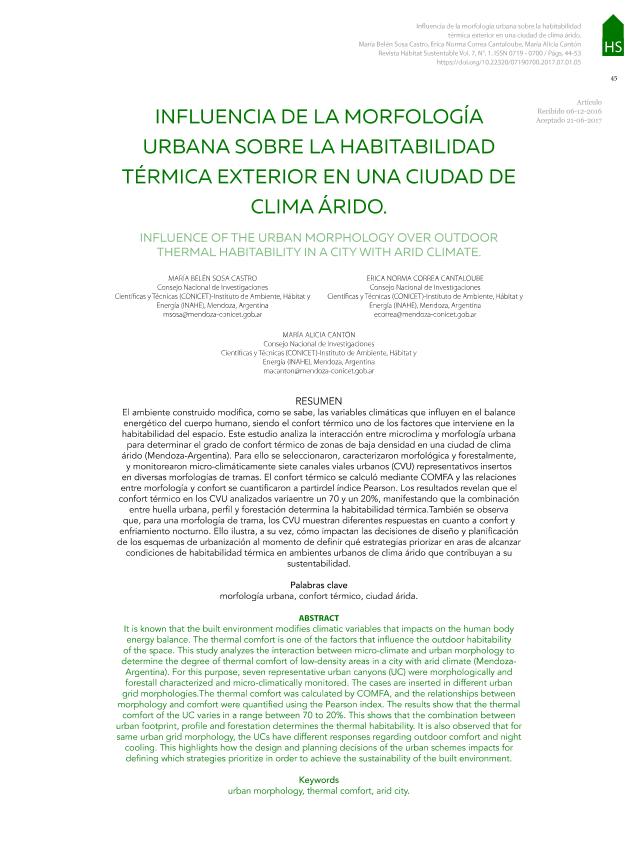Mostrar el registro sencillo del ítem
dc.contributor.author
Sosa, María Belén

dc.contributor.author
Correa Cantaloube, Erica Norma

dc.contributor.author
Canton, Maria Alicia

dc.date.available
2021-03-03T16:06:00Z
dc.date.issued
2017-06
dc.identifier.citation
Sosa, María Belén; Correa Cantaloube, Erica Norma; Canton, Maria Alicia; Influencia de la morfología urbana sobre la habitabilidad térmica exterior en la ciudad de clima árido; Universidad del Bío-Bío; Hábitat Sustentable; 7; 1; 6-2017; 44-53
dc.identifier.issn
0719-0700
dc.identifier.uri
http://hdl.handle.net/11336/127301
dc.description.abstract
Se conoce que el ambiente construido modifica las variables climáticas que influyen en el balance energético del cuerpo humano; siendo el confort térmico uno de los factores que interviene en la habitabilidad del espacio. Este estudio analiza la interacción entre micro-clima y morfología urbana para determinar el grado de confort térmico de zonas de baja densidad en una ciudad de clima árido (Mendoza-Argentina). Para ello se seleccionaron, caracterizaron morfológica y forestalmente, y se monitorearon micro-climáticamente siete canales viales urbanos (CVU) representativos insertos en diversas morfologías de tramas. El confort térmico se calculó mediante COMFA, y se cuantificaron las relaciones entre morfología y confort mediante el índice Pearson. Los resultados muestran que el confort térmico en los CVU analizados varía en un rango entre 70 a 20%, manifestando que la combinación entre huella urbana, perfil y forestación determinan en conjunto la habitabilidad térmica. También se observa que para una determinada morfología de trama, los CVU muestran diferentes respuestas en cuanto a confort exterior y enfriamiento nocturno. Esto pone en relevancia cómo impactan las decisiones de diseño y planificación de los esquemas de urbanización al momento de definir que estrategias priorizar con el fin de alcanzar la sustentabilidad del ambiente construido
dc.description.abstract
It is known that the built environment modifies climatic variables that impacts on the human body energy balance. The thermal comfort is one of the factors that influence the outdoor habitability of the space. This study analyzes the interaction between micro-climate and urban morphology to determine the degree of thermal comfort of low-density areas in a city with arid climate (MendozaArgentina). For this purpose, seven representative urban canyons (UC) were morphologically and forestall characterized and micro-climatically monitored. The cases are inserted in different urban grid morphologies.The thermal comfort was calculated by COMFA, and the relationships between morphology and comfort were quantified using the Pearson index. The results show that the thermal comfort of the UC varies in a range between 70 to 20%. This shows that the combination between urban footprint, profile and forestation determines the thermal habitability. It is also observed that for same urban grid morphology, the UCs have different responses regarding outdoor comfort and night cooling. This highlights how the design and planning decisions of the urban schemes impacts for defining which strategies prioritize in order to achieve the sustainability of the built environment.
dc.format
application/pdf
dc.language.iso
spa
dc.publisher
Universidad del Bío-Bío

dc.rights
info:eu-repo/semantics/openAccess
dc.rights.uri
https://creativecommons.org/licenses/by-nc-sa/2.5/ar/
dc.subject
MORFOLOGÍA URBANA
dc.subject
CONFORT TÉRMICO
dc.subject
CIUDAD ÁRIDA
dc.subject.classification
Otras Ingeniería del Medio Ambiente

dc.subject.classification
Ingeniería del Medio Ambiente

dc.subject.classification
INGENIERÍAS Y TECNOLOGÍAS

dc.title
Influencia de la morfología urbana sobre la habitabilidad térmica exterior en la ciudad de clima árido
dc.title
Influence of the urban morphology over outdoor thermal habitability in a city with arid climate
dc.type
info:eu-repo/semantics/article
dc.type
info:ar-repo/semantics/artículo
dc.type
info:eu-repo/semantics/publishedVersion
dc.date.updated
2020-10-06T19:11:28Z
dc.journal.volume
7
dc.journal.number
1
dc.journal.pagination
44-53
dc.journal.pais
Chile

dc.description.fil
Fil: Sosa, María Belén. Consejo Nacional de Investigaciones Científicas y Técnicas. Centro Científico Tecnológico Conicet - Mendoza. Instituto de Ambiente, Hábitat y Energía; Argentina
dc.description.fil
Fil: Correa Cantaloube, Erica Norma. Consejo Nacional de Investigaciones Científicas y Técnicas. Centro Científico Tecnológico Conicet - Mendoza. Instituto de Ambiente, Hábitat y Energía; Argentina
dc.description.fil
Fil: Canton, Maria Alicia. Consejo Nacional de Investigaciones Científicas y Técnicas. Centro Científico Tecnológico Conicet - Mendoza. Instituto de Ambiente, Hábitat y Energía; Argentina
dc.journal.title
Hábitat Sustentable
dc.relation.alternativeid
info:eu-repo/semantics/altIdentifier/url/http://revistas.ubiobio.cl/index.php/RHS/article/view/2616
Archivos asociados
